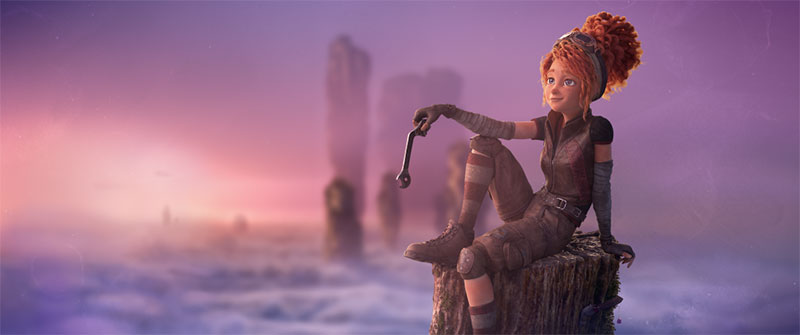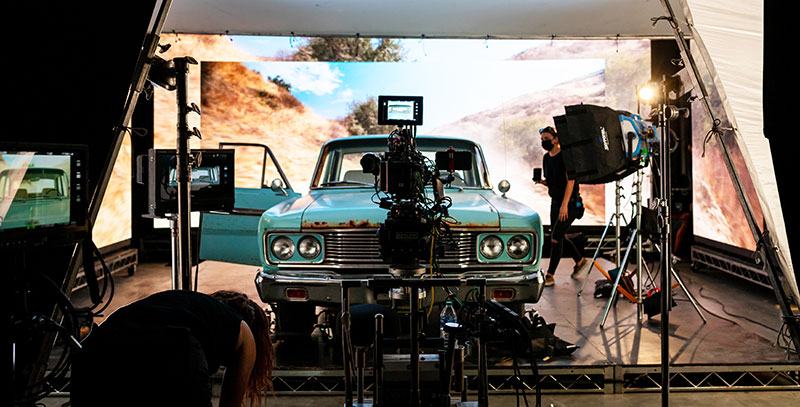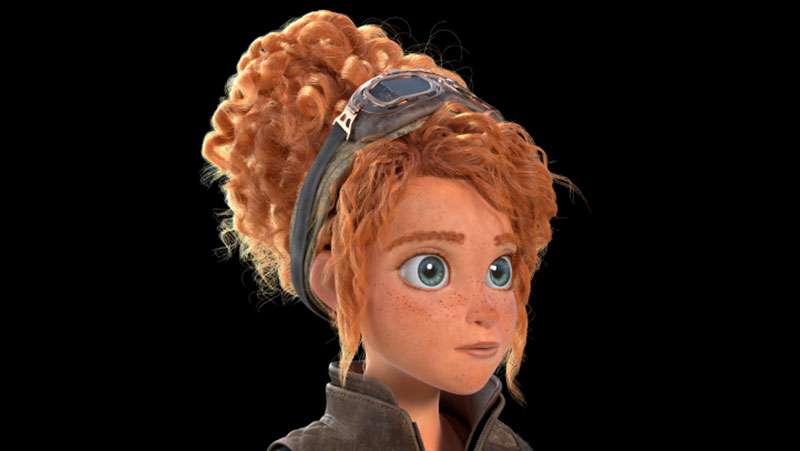ASWF launched two projects from SIGGRAPH, one for production-grade sample content to aid product development, and an Open Review tool for media playback, review and approval.

Noa, created by AWS FuzzyPixel
The Academy Software Foundation (ASWF), the motion picture industry’s organisation for advancing open source software development across image creation, VFX, animation and sound, has launched two new projects from SIGGRAPH 2022.
One of these is an open source library called Digital Production Example Library (DPEL), housing production-grade sample content, granting public access for developers, researchers and educators to use the content for testing and other purposes. By establishing this vendor-neutral repository, the idea is to support more robust software and hardware development that can meet the demands of real world production.
The DPEL project serves a need for production-grade sample content in order to adequately test hardware and software in development and make sure that it can scale to the demands of the film and TV content creation process. Such content is normally held inside separate studios, with legal protection, copyright and policies that make it difficult to distribute to developers, researchers and educators.
The goals of DPEL are to encourage, curate and publish production-grade sample assets that will be of value to the broader community. Working as a vendor-neutral platform, along with a uniform license agreement, will help make it easier for studios to contribute content.
Hosted Assets
One of DPEL’s first hosted assets is the American Society of Cinematographer’s Standard Evaluation Material II (StEM2), which comprises an entire 17-minute short film, 'The Mission', designed specifically to stress-test modern image processing and exhibition systems, including high dynamic range and high frame rates.

Shooting the ASC's 'The Mission'
Other assets hosted by DPEL at the time of the launch include Animal Logic’s ALab Phase 2, a full production scene with over 300 production high quality assets, two animated characters and baked procedural fur and fabric, all supplied as a part of the first open-sourced USD scene and shot context from a studio. [See a bigger article about this project HERE.]
Intel’s second Volumetric Clouds Library is a collection of 30 VDB cloud assets, ranging from dense to sparse clouds, at resolutions ranging from quite small (< 1 MB) to quite large (> 8 GB).
Noa, to in-house production team FuzzyPixel created by Amazon Web Services, is a complete animatable main character, with rig, geometry, textures and hair groom, built in Maya. Noa is the hero of the team’s short film ‘Spanner’.
OPEN REVIEW INITIATIVE
AWSF’s second project launching at SIGGRAPH is the Open Review Initiative, with initial code contributions from member companies Autodesk (RV), DNEG (xSTUDIO) and Sony Pictures Imageworks (itView). As a hosted project, the new Open Review Initiative aims to build a unified, open source toolset for playback, review and approval of motion picture and professional media.

Intel Volumetric Cloud Library
In the case of Autodesk RV, for instance, the application contains a specialised media player that allows VFX and animation artists to view high-resolution images and sequences directly with production teams in real time, and compare different versions while collaborating on projects. Autodesk acquired RV from Tweak Software 2015 and integrated it into the ShotGrid production management platform, which has enabled live collaborative review sessions.
“RV is critical to our animation pipeline, and allows us to share our integrations with the industry. It's similar to what we’ve done with Autodesk and Pixar to integrate our ALUSDMaya toolsets into the Autodesk-supported maya-usd plugin,” said Darin Grant, Animal Logic CTO and AWSF board member. “As they did with their contributions to OpenColorIO, Autodesk’s willingness to support open source by sharing foundational libraries and toolsets will help push the industry forward.”
The Academy Software Foundation formed a Review & Approval Working Group in 2021, in response to how the pandemic was shaping digital content workflows across the entertainment industry. The Working Group’s goals were to investigate the state of playback and review systems and, from there, take the opportunity to develop a common set of media animation and VFX tools for collaborators to drive the creative review process throughout production.

Noa render
The Open Review Initiative is now forming in the sandbox stage – the Foundation’s earliest project stage, serving as a stepping stone from Working Group to project with resources for continued development and a neutral forum for industry-wide collaboration.
Foundry in the Sandbox
OpenAssetIO from Foundry, a founding member of the ASWF, has been accepted as the ASWF’s first project to enter the Foundation in the sandbox stage, and will graduate to the incubation stage within one year. OpenAssetIO aims to give artists the ability to find and share deeply connected assets, regardless of how or where they’re stored, and will become an open-source interoperability standard between tools and asset management systems, reducing the integration effort and maintenance overhead of content creation pipelines. OpenAssetIO standardises scalable asset-centric workflows by enabling tools and asset management systems to freely communicate with each other, without the need to know any specifics of their respective implementations.
“As the demand for more content continues to rise, our industry is scaling up with nimbler and more distributed ways of working. Our hope is that OpenAssetIO lays a foundation over which any creative tool can build better workflows to meet the challenge of how artists need to collaborate at scale,” said Mathieu Mazerolle, Director of Product, New Technology at Foundry. “We’re excited to have the Foundation’s support behind this project and, with it, the open source spirit that we believe is essential for sustainable industry transformation.”
OpenAssetIO’s journey into the ASWF’s lifecycle was presented as part of OpenSource Days 22 on 8 August at SIGGRAPH.

Animal Logic is enthusiastic about DPEL
Technical Steering Committee
The Open Review Initiative will be guided by an umbrella Technical Steering Committee (TSC) comprised of lead architects and maintainers from each company, as Autodesk, DNEG and Imageworks respectively make their RV, xSTUDIO and parts of the itView ecosystem available to the open source community for the first time. Prioritizing its initial focus on playback, the umbrella TSC will guide the strategy for each initially standalone code repository, with the goal of their gradual convergence into a cohesive, state-of-the-art review and approval framework. The TSC will be led by a combination of members from the contributing companies and a diverse cross-section of the community of engineers and users invested in this problem space.
“The review and approval landscape encompasses a deceptively large number of interconnected systems – including playback, production tracking, asset management, editorial integration, transcoding, transport and annotations,” said Erik Strauss, who served as chair of the Review & Approval Working Group and will continue to participate as the umbrella TSC chair for the Open Review Initiative. “Each of the code contributions from Autodesk, DNEG and Imageworks bring significant value and address different areas that we aim to incorporate into a best-in-class system. Their convergence over time, driven by a shared vision and contribution strategy, is the most efficient approach to solving the needs of the whole creative community.”
Developers interested in learning more or contributing to the Open Review Initiative can visit the intro here. Companies interested in supporting the mission of the Academy Software Foundation can learn more and join here. www.aswf.io


